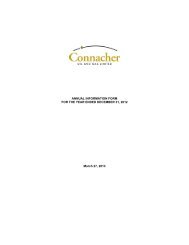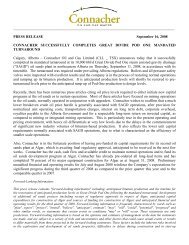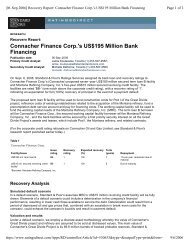ANNUAL REPORT 2011 - Connacher Oil and Gas
ANNUAL REPORT 2011 - Connacher Oil and Gas
ANNUAL REPORT 2011 - Connacher Oil and Gas
Create successful ePaper yourself
Turn your PDF publications into a flip-book with our unique Google optimized e-Paper software.
AR <strong>2011</strong><br />
PG 35<br />
ACCOUNTING POLICIES AND ESTIMATES<br />
ADOPTION OF INTERNATIONAL FINANCIAL <strong>REPORT</strong>ING STANDARDS<br />
On January 1, <strong>2011</strong>, the company adopted International Financial Reporting St<strong>and</strong>ards (“IFRS”) for financial reporting purposes, using a transition<br />
date of January 1, 2010. The financial statements for the year ended December 31, <strong>2011</strong>, including required comparative information, have been<br />
prepared in accordance with International Financial Reporting St<strong>and</strong>ards 1, First-time Adoption of International Financial Reporting St<strong>and</strong>ards.<br />
The following provides a summary reconciliation of <strong>Connacher</strong>’s 2010 net loss before taxes calculated in accordance with previous GAAP <strong>and</strong><br />
<strong>Connacher</strong>’s 2010 net loss after taxes calculated in accordance with IFRS, along with a discussion of the significant IFRS accounting policy changes.<br />
Summary Net Loss Reconciliation<br />
(Canadian dollar in thous<strong>and</strong>s) YTD 2010<br />
Net loss per previous GAAP $ (38,798)<br />
Exploration <strong>and</strong> evaluation expense (964)<br />
Depletion, depreciation, amortization <strong>and</strong> impairment 1,305<br />
Disposition of oil <strong>and</strong> gas properties (5,287)<br />
Compensation 44<br />
Unwinding of discount on decommissioning liabilities 812<br />
Interest in associate 3,140<br />
Unrealized loss on revaluation of Convertible Debentures (228)<br />
Income taxes (4,693)<br />
Net loss per IFRS $ (44,669)<br />
ACCOUNTING POLICY CHANGES<br />
The following discussion explains the significant differences between <strong>Connacher</strong>’s previous GAAP accounting policies <strong>and</strong> those applied by the<br />
company under IFRS. IFRS policies have been retrospectively <strong>and</strong> consistently applied except where specific IFRS 1 optional <strong>and</strong> m<strong>and</strong>atory<br />
exemptions permitted an alternative treatment upon transition to IFRS for first-time adopters. IFRS 1 requires the presentation of comparative<br />
information as at the January 1, 2010 (“transition date”) <strong>and</strong> subsequent comparative periods as well as the consistent <strong>and</strong> retrospective application<br />
of IFRS accounting policies. To assist with the transition, the provisions of IFRS 1 allow for certain m<strong>and</strong>atory exceptions <strong>and</strong> optional exemptions<br />
for first-time adopters. The significant m<strong>and</strong>atory exceptions <strong>and</strong> optional exemptions applied under IFRS 1 in preparing the consolidated financial<br />
statements are set out below followed by a discussion regarding the impact of individually significant items.<br />
Deemed cost election for oil <strong>and</strong> gas properties<br />
Under previous GAAP, the company followed the “full cost” method of accounting for petroleum <strong>and</strong> natural gas activities under which all costs directly<br />
associated with the acquisition of, the exploration for, <strong>and</strong> the development of petroleum <strong>and</strong> natural gas reserves were capitalized on a country–<br />
by–country cost centre basis. The company had one cost centre, Canada, for the upstream segment. Costs accumulated within this one cost centre<br />
were depleted using the unit–of–production method based on proved reserves determined using estimated future prices <strong>and</strong> costs. Upon transition<br />
to IFRS, the company was required to adopt new accounting policies for upstream activities, including the segregation of exploration <strong>and</strong> evaluation<br />
costs <strong>and</strong> petroleum <strong>and</strong> natural gas properties. Under IFRS, exploration <strong>and</strong> evaluation costs are those expenditures for which technical feasibility<br />
<strong>and</strong> commercial viability has not yet been determined, are presented separately on the balance sheet as exploration <strong>and</strong> evaluation assets <strong>and</strong> may<br />
or may not be amortized based on the company’s accounting policy. Petroleum <strong>and</strong> natural gas properties include those expenditures where technical<br />
feasibility <strong>and</strong> commercial viability has been determined, are presented as a part of property, plant <strong>and</strong> equipment on the balance sheet <strong>and</strong> are<br />
depleted <strong>and</strong> depreciated on a segregated basis based on the company’s accounting policy. The company adopted the IFRS 1 exemption whereby the<br />
company deemed its January 1, 2010 IFRS upstream asset costs to be equal to its previous GAAP historical upstream property, plant <strong>and</strong> equipment<br />
net book value. Accordingly, exploration <strong>and</strong> evaluation costs were deemed equal to the unproved properties balance <strong>and</strong> the petroleum <strong>and</strong> natural<br />
gas properties costs were deemed equal to the remaining upstream full cost pool balance. The petroleum <strong>and</strong> natural gas property costs were<br />
allocated for depletion, depreciation <strong>and</strong> impairment testing purposes on a pro rata basis using proved reserves values at the transition date.<br />
Leases<br />
The company has elected not to reassess whether an arrangement contains a lease under International Financial Reporting Interpretations Committee<br />
Interpretation 4 for contracts that were assessed under previous GAAP.<br />
Business Combinations<br />
IFRS 3, “Business Combinations” has not been applied to business combinations that occurred before the transition date.<br />
Borrowing Costs<br />
Borrowing costs directly attributable to the acquisition or construction of qualifying assets were not retrospectively restated prior to transition date.












